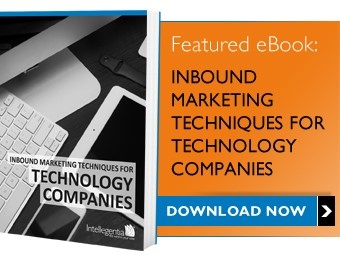
For technology companies in particular, attracting high quality leads is a top priority. Surprisingly then, 61% of B2B marketers still send all the leads they receive directly to sales, while only 27% of those leads will actually be qualified for a sales call. This is exactly why Inbound Marketing is a growing solution for businesses – a methodology that naturally attracts the right prospects to your brand.
It’s no longer all about the chase. Inbound Marketing aims to attract top quality leads directly to your company, through the creation of useful and relevant content that these prospects actually want to consume. It’s a direct discussion - a personable way of getting the right potential customers engaging with your business.
So how does this help companies in the technology sector?
1. Creating buyer personas
Knowing your target market has been the foundation of marketing campaigns for years – there’s nothing new there. Inbound Marketing, however, differentiates itself by digging deeper into not only who your ideal prospect is, but also exactly why they need your product or service - the problems they are looking to solve. A buyer persona is a detailed representation of your ideal prospect profiles and these can be segmented based on common characteristics, goals, or pain points. Whereas an ideal prospect might be described using the demographics of a company - size, location, industry etc - buyer personas add the dimension of the person. Many technology purchases involve people from IT, Finance, Purchasing and Operations. Each of them will have a different focus - integration with other systems, ROI, cost reduction, efficiency increases etc. Having such precise knowledge of the different groups of people you want to reach AND why, will allow your marketing team to more accurately address, attract and qualify leads.
2. Lead nurturing
Technology buyers demand a wealth of information at every stage of their buying journey - distributing relevant and helpful content to your target market narrows the gap between buyer and seller. Content marketing draws in potential buyers. It is estimated that 60% of a buyers journey is carried out before speaking to a sales person, so it makes sense to provide as much information as possible to those people in that early research phase. But what about later stages in the sales cycle? Lead nurturing comes into play, when a lead is spotted (right persona, right company) but not yet ready to buy. For a technology company the sales cycle is often long (up to 18 months in some cases), so lead nurturing is critical. In the past this is where leads often got "lost" - where marketing has handed them over but sales have said they aren't ready to buy. For these leads, providing relevant content at precise times in their extensive buying cycle, can dramatically increase the chances of you closing that lead rather than your competitors!
3. Lead Definition and Lead Scoring
This gets your marketing and sales teams working together to benefit one another, as well as the business. Sales and marketing teams should agree on the criteria, or lead scoring threshold, which pinpoints exactly when a lead is ready to be passed from marketing to sales. Essentially, this is a list of key attributes that qualify a lead e.g. company size, job role (which suggests authority), location, industry. A Marketing Qualified Lead (MQL) is someone in your pipeline that your marketing team identifies as having met the agreed criteria for a great lead and can be passed to the sales team. A Sales Qualified Lead (SQL) is one that is deemed by Sales to be ready to be worked on. Sales and marketing teams should create an SLA that describes the MQL criteria, and the time by which sales need to turn the lead into an SQL or hand it back to marketing for further lead nurturing. This avoids the "lost" leads we mentioned in the last section. Lead scoring adds another dimension to this process for those businesses who have an abundance of leads and need to prioritise them, or for those where the MQL criteria is more complex than a simple "the lead meets all the above criteria".
4. Embracing the power of social
By spending as little as 6 hours per week on social media, over 66% of marketers see lead generation benefits. Using social media as a marketing tool is essential in 2015, with consumers of all levels using Facebook, Twitter and LinkedIn as a go-to information source, and LinkedIn being the number one social networking tool for business users. So it’s simple – be where your customers are! Today, there are a number of tools your team can use to actively track, manage and nurture leads developed from your social media activities. For instance, HubSpot's Social Inbox tool allows you to see who is talking about your company, what your competitors are saying and posts about industry / product related topics. The software allows you to engage with all streams from one user friendly portal.
Additionally, tools like this allow you to analyse success and effectively incorporate social media interactions into your lead scoring system.
5. Asking the right questions.
Once that MQL criteria has been set, it’s all systems go! Inbound marketers capture prospect details using forms on a company website with an offer behind them (usually a free whitepaper/PDF/eBook). The questions asked on these forms are all based on the information that’s needed from your lead to nurture them through the sales funnel and determine their quality.The trick is to keep these forms as simple as possible. Use smart forms that capture essential details first, then prompt for one or two different pieces of information each time that person revisits your website. The objective is to move prospects through the funnel - providing more valuable content to them in exchange for one or two more pieces of information from them - until you have all the answers to determine whether or not they represent an MQL.
Potential buyers will only provide information if they think that there is corresponding value to be had from the content offer behind your form. So, if you want to ask company specific questions about annual revenue and biggest challenges, make sure the content you offer is going to be valuable. ROI calculators, software buyers guides, hardware performance comparison charts, detailed case studies....are all examples of high value content.
The goal for marketers in technology companies is to generate more high-quality leads, and the more detailed information you obtain, the better you can quality prospects.
With inbound practices producing 54% more leads than traditional outbound practices and costing 61% less per lead, the fact that this is also proven to produce such high quality leads for your sales team makes going inbound a no-brainer.
To find out more about Inbound Marketing and why it is essential to the growth of your technology company download our e-book:

.png?width=250&height=76&name=Intellegentia%20Logo%20(MAIN).png)